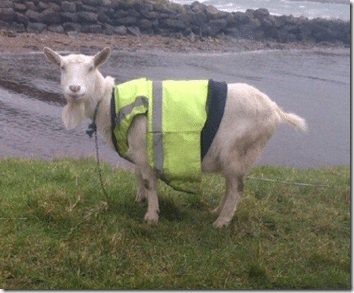Safety Manager – an Ultimate Scapegoat
 I heard an interesting story recently from an acquaintance of mine which prompted me to write this article.
I heard an interesting story recently from an acquaintance of mine which prompted me to write this article.
As the most senior corporate Safety Manager for the organisation with no operationally based direct reports, she was assigned a personal goal for the year of delivering 20% reduction in TRIFR and a zero LTIFR. In addition, she was made accountable for the execution of the organisational annual safety plans which were completely operational in nature. The organisation had just completed its third year in the row where operational safety plans failed to be executed and implemented from the operational perspective. As a result, formal safety targets and KPI’s pertaining to new financial year were removed from the operational senior managers and assigned to a Safety Manager instead.
When the Safety Manager asked for some formal and increased authority over the operational activities she was denied and told to ‘use her influence’. As the conversation with the CEO (her direct boss) drifted into who is really accountable for safety in the organisations one clear message was delivered back to her.
‘We do what we need to do to hit operational targets and you do your best to keep us safe’. She was also told not to publicly declare that safety is a line management responsibility as this made some senior line managers ‘uncomfortable’.
Sounds senseless and it truly is. How does a support function ‘own’ the output which is completely in control of another organisational function, specific organisational structure and its managers? The answer is it cannot be done successfully. This is an illusion and a true meaning of setting someone up for a failure.
But how can something like this exist? What makes otherwise smart and competent people so reluctant to assign accountability for safety in work execution where it truly belongs – line management? What makes them skirt around the ownership of safety and believe in fairy tales that one of the most critical and most difficult organisational function can be delegated to others, managed ad hoc and outside of all other normal processes, organisational structure and operational accountability?
The answer lies in leadership.
Denial of accountability for safety as a core operational process
If the most senior people in the organisation responsible for operational execution of work do not feel directly responsible, and are not made accountable for safety, two critical things occur. Safety is delegated to someone else and this skewed balance and misguided transference of accountabilities penetrates all management levels, amplifies along the way and ends up all the way down to a supervisor and his crew. In this environment, ‘divorce’ from safety ownership at operational level is the most obvious and is easily recognisable however it is indeed created much further upwards in the organisation. Where this occurs, safety advisors and even safety representatives are seen to be accountable for safety at the shop floor level. As this is obviously not achievable, the result is an illusion of ownership and a repeat of failures with all associated human and financial cost.
There are many reasons why this misguided delegation of safety accountabilities and responsibilities occurs. Some common factors for this are previous failures of operational personnel to own safety and execute safety plans, poor understanding of safety, risk and leadership at senior levels, reluctance of executives to hold senior operational managers accountable for their safety performance or hidden beliefs that safety stands in the way of increased production targets. Regardless of the angle this is analysed from, the conclusion is always the same – lack of understanding how safety works for the business and how it is achieved from the leadership perspective, resulting in direct leadership failures.
Another effect of this transference of accountabilities is creation of a culture where safety becomes a secondary priority in operational execution of work. This ‘divorce’ of operational departments and stakeholders from their primary accountabilities (safety and reliability) creates a culture where safety always belongs to someone else who does not have authority to actually execute it. This is a real recipe for disaster, unfortunately with plenty of examples in all industries.
· Assigning inappropriate KPI’s and Illusion of shared responsibility.
To paraphrase Deming, if everyone is accountable, no one is really accountable. Assigning responsibility and accountability for safety to everybody, and I mean all organisational functions is a good way of ensuring confusion and dilution of safety ownership at operational levels, and this is where safety is really made or broken. Assigning responsibility and accountability for safety execution to a support function is equal to sticking a head in the sand. It makes absolutely no sense as the problem will not go away.
To be successful, each organisational function needs to have their accountability for safety performance specifically defined into a fine detail (SMART goals), written into KPI’s and individual targets. Functional influence only goes so far. Support functions must be accountable for providing timely support with training, developing, coaching, guiding, mentoring and facilitating. Operational stakeholders on the other hand must be accountable for adequate resourcing and actual physical implementation of safety strategies and systems of safe work execution, at the sharp end. It really does not work any other way.
Diluting safety responsibilities and accountabilities and hiding behind a generic ‘collective accountability’ for safety is a sure way to suffer damaged relationships and a collective failure, with some tragic and costly consequences. Undefined, generic and collective functional responsibilities and accountabilities for safety ensure only one thing – a collective failure. When this happens, safety managers are often used as sacrificial lambs, they are often thrown under the bus and the New Year starts with new false hopes and promises. In the meantime human and financial costs are mounting and heads remain firmly buried in the sand.
Organisations where this occurs tend to repeat their negative performances and are stuck in the space where leadership and ownership in safety is well verbalised but generally very poorly understood and practiced. They can benefit from ‘back to basic’ approach in leadership and relevant training at the most senior levels.
Safety as an output can only be achieved from the operational perspective and only if key operational stakeholders are owners of safety performance and are embracing that ownership. This ownership needs to flow, relentlessly, from CEO as the most senior line manager in the organisation, to chief operating officer, general managers and operational management and supervision. Making support functions accountable for operational outputs has no value other to create an illusion of collective accountability and a real effect of collective failure.
This probably all sounds as a common sense to most; however the reality is continuously proving to us that what we commonly consider to be common sense is often not so common at all.
See also:
Safety Professionals–The Piggy in The Middle?
 Anyone for a game of Piggy in the Middle….? do you remember playing that game when you were a kid? You know, the one where you stand in the middle of a group of friends who continually throw a ball to one …… Enjoy the rest of the article >>>>>
Anyone for a game of Piggy in the Middle….? do you remember playing that game when you were a kid? You know, the one where you stand in the middle of a group of friends who continually throw a ball to one …… Enjoy the rest of the article >>>>>



Mario says
I had a short stint as SHE Manager for a multi national firm a few years ago, experienced the same nonsense, they even tried to intimidate me with with their corporate lawyer. I was walked out the door with a shoe box with all my sh. Its a hard role for people with ethics and principles. It often forces you to choose between economic and ego benefits vs morals and ethics. When the job started affecting my family and marriage I hit the detonate button.
Admin says
Yep – same reason I walked away from a Safety Consultant role in 2009 – it had already cost me my marriage and almost my life. I havent looked back and I feel for those still bashing thier heads against that wall and trying to balance what they know is ethical against what is expected of them.
Rob Long says
The reason why people are so alienated in safety is because there is so little study of ethics, power, politics and role-identity in the WHS curriculum. The naivety and unprofessional nature of this is breathtaking. The fact that so much compliance politics is exhibited by associations and regulators shows that safety will not become professional for many years.
Bob Coughlan says
‘The reason why people are so alienated in safety is because there is so little study of ethics, power, politics and role-identity in the WHS curriculum. The naivety and unprofessional nature of this is breathtaking. The fact that so much compliance politics is exhibited by associations and regulators shows that safety will not become professional for many years.’
During my years in the HSE field, I’ve encountered effective leaders who take ownership and exhibit accountability, and ‘wannabe’ leaders, who are essentially just sociopathic bullies, who are yes-men to their higher ups. These ‘wannabe’ leaders are kept in place because their higher-ups share the same traits. It’s been an absolute pleasure to work for and with effective leaders. Of course, there’s leaders who are at various points on the spectrum between exemplary and abominable.
Sociopathic leadership teams often love to crow about how important safety is, and they love to patronize the safety personnel about how ‘important’ they are and how they are ‘needed’ to ‘keep the guys safe’. This in itself is already a slipping of the mask, but the mask truly slips when there’s some kind of operational mishap, or delay.
No amount of training or awareness (targeted at safety personnel) in ethics, power, politics, and role-identity will change the sociopathic treachery under sociopathic leaders, unless the toxic leaders are either rooted out, or receive the training themselves, and demonstrate competence in applying these concepts to all aspects of the operation for which they are paid, often huge sums, to be accountable.
Expecting Safety people to ‘change an organization from within’ is an often unreasonable burden when sociopathic bullies not only exert their influence on the safety aspects of operations, but all other aspects as well (finance, logistics, HR, legal, production etc etc).
Those of us who do notice the double-standards, sociopathy, dysfunction etc often just become disillusioned when they take a long hard look behind the curtain. Especially when they are frequently being saddled with what amounts to the monkey being expected to be the organ-grinder’s life-coach / therapist.
Rob Long says
Spot on Bob. I agree that no amount of training will change this but without any focus on these the industry just helps perpetuate the sociopathy you talk about. If we want to see the industry act professionally then the place to start is the curriculum, otherwise the system just pushes out graduates of increasing naivety and fodder actors for sociopaths.
Bob says
More than 4 years old, and this article still resonates.